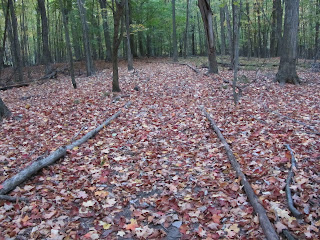Saturday was a good day at Forest Hill for a hike with my dog, Remi. The early morning weather was mostly cloudy with a temperature of 43 degrees and a stiff breeze out of the northwest. I descended the hill to the west, hiked past Mallard Marsh through Bobolink Meadow where the Milkweed pods were bursting open to expose the silky, white seeds. Also, I wondered how our Bobolinks were doing on their lengthy migration to Argentina. Entered North Woods , I noticed the Poison Ivy leaves were changing colors. Continuing west, I recalled my surprise earlier in the week to see a young, spotted fawn lying next to the trail well beyond the breeding season. It appeared thin and weak and I didn’t think it would survive the night. However, the next day it was gone, hopefully back with its mother. Exiting the woods, I gazed south across Succession Field and saw how the birch trees on the edge of South Woods had turned yellow. I circled the field where I noticed leaves of Silky Dogwood shrub remained green. Entering South Woods, I walked along the edge of Swanson Swamp where I noticed some of the Witch Hazel trees were displaying their dainty yellow flowers. Sometimes called Winter Bloom, this plant was used by Native Americans to cure skin irritations and lung problems, and it is still cultivated today to produce a skin toner. Exiting the woods, I continued to Artist Overlook where I looked east and noticed patches of Gray Dogwood displaying their fall colors. I followed south trail where I spotted some scarlet red Virginia creeper leaves. At Frog Fen, I turned south toward Brady Cemetery where I noticed how the leaves of Red Osier Dogwood shrubs had turned a burgundy red color. I entered the cemetery and noticed the White Pine trees were shedding their yellow needles. I passed the gravestones to view the hidden container behind the huge Red Maple in the southeast corner that I had found several weeks ago while geocaching. I left the cemetery, walked through Native Grassland and paused at Grebe Pond where I saw three Mallards fly off. Heading north, I came to the barn and spotted a freshly killed Deer Mouse by the west entrance. Next, I walked to the north side where I noticed a Black Walnut tree with lots of husks hanging and on the ground. Walnut husks can be chewed for an upset stomach. When used in skin care or dental products, fine bits of husk offer gentle abrasive properties for toothpaste products and facial scrubs. I opened one of the husks to see some small white maggots called Walnut husk maggots. After feeding on the husk for 3 to 5 weeks, mature maggots burrow several inches into the soil to pupate. Most emerge as adult flies the following summer, but some remain in the soil for 2 or more years. Finally, we arrived back at the van and took off for home.
October days! How nature shouts,
so many ways
With bundled sheaves and rustling leaves,
in splendid blaze.
O, what sights! What nippy nights,
harbingers of change soon
To come, with frosty bites,
shivery delights, and harvest moon.
Winter will march on! A howling, blustery,
mountain king,
Scattering furry ones, scampering,
gathering quondam glean.
Pond and lake with icy sheen-
unlikely resting place,
For airborne tenacities and dancing
dervish lacy flakes.
Carolyn Head

No comments:
Post a Comment